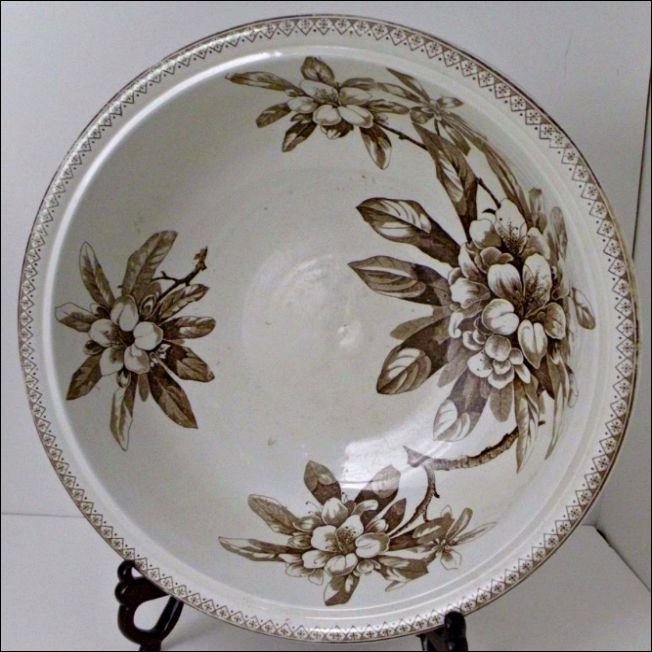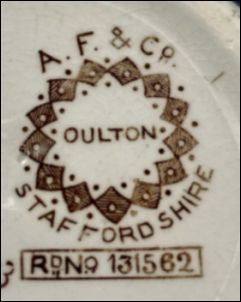![]()
|
Alfred Fenton & Sons (& Co) |
Location and period of operation:
|
Alfred Fenton & Sons (& Co) |
Hanley |
1887 |
1901 |
|
Earthenware manufacturer at the "Brook Street Works", Hanley, Stoke-on-Trent, England
|
Formerly: Worthington & Son
Examples of ware:

Hand decorated gilt jug
A F & S
c. 1887-93
photo courtesy: Caleb
Schneider
Tunstall pattern
this pattern appears to have been first produced by Thomas Podmore & Co (c.1830-34)
Alfred
Fenton likely purchased the transfer plates from a subsequent
company to Podmore or from an engraver
 dark green transfer ware - dinner set in the Tunstall pattern |
 A F & S c. 1887-93 |
photos courtesy: Maggie Hull
 dark blue transfer ware - meat platter in the Tunstall pattern |
 TUNSTALL A F & S c. 1887-93 |
This platter was found (c. 2024) in an out of the way shop in the South Australian Outback in the town of Ceduna.
photos courtesy: Michael van Veen


Serving Dish
A F & Co
c.
1893
- 1901
 wash basin in the Oulton pattern A printed design of a rhododendron twig with leaves and differing number clusters of blossoms dependant on the size/shape of the ware. A
popular pattern printed in black, brown, blue , red |
 A F & Co the
registration number 131562 shows that the pattern was registered on the '& Co' was in use c.1893 - 1901 |


Large platter in the ELSMERE
pattern
A F & Co
c.
1893
- 1901
Marks & initials used on ware for identification:
A F & Sons
Marks
'A F & S' are probably pre 1893
when John Fenton left the business
c. 1887-93
A F & Co
c.
1893
- 1901
|
c1887-93 |
c. 1893 - 1901 |
marks incorporating the Royal Arms
|
|
Tunstall is the pattern name |
A F & S
c. 1887-93
 A F & Co |
 A F & Co |
 A F & Co Staffordshire |
c. 1893 - 1901
the name of the pattern is often included
Brook Street Works:
- click for more information on the Brook Street Works -
Details of insolvency:
The London Gazette, January 10, 1899

notice of a Receiving Order against Alfred Fenton & Sons
When a receiving order is made, it means that the Court
appoints the official receiver to take charge of the debtor's estate.
The Herald, Melbourne,
Victoria, Australia
Wed 3 May 1899
|
GLASS AND
CHINA. A. FENTON & SONS. INSOLVENCY EXAMINATION. In the Insolvency Court today, before his Honor Judge Molesworth, an examination was held in the estate of Alfred Fenton and Sons, glass and china merchants, of this city. Mr Pigott (instructed by Messrs Blake and Riggall), appeared for the trustee: Mr Eagleson (Instructed by Messrs Madden and Butler), appeared for Mr Arthur Fenton. Arthur Fenton, a merchant, and member of the firm of Alfred Fenton and Sons, was examined by Mr Pigott. Witness said that he had signed the schedule of the firm produced, and had also filed his private schedule. The partners In the firm at the time of sequestration were his father, Alfred Fenton, his brother James, and himself. Prior to the sequestration witness's brother, John, had been a member of the firm, and remained so till 1893, when he went away from his duties in Melbourne. John was now in Wellington. New Zealand. Witness thought the concern was a paying one in 1893. When John went away the other members took steps to remove him from the partnership. Witness was aware that John's name was included in the firm in the insolvency proceedings in the English business. Witness knew little or nothing of the English proceedings, as his brother James did not keep him informed. John was, he thought, earning L2 or L2 10s as an assistant in a shop in New Zealand. Witness was cognisant of the business in Melbourne during the last three years, but knew nothing about the English business, which was managed by his brother James. Within those three years the father, Alfred Fenton, visited England and returned with a report respecting the English business, but the report did not contain the particulars witness desired, and he was dissatisfied with his brother's management. He thought the financial condition of affairs in England was bad, as the firm owed too much. Afterwards his brother's reports led him to think that the condition had improved. Witness had a Melbourne business in Elizabeth street, known as Fenton's Emporium, which was started in November, 1894, with the permission of the firm. His father joined with him in this business in Elizabeth street. |
Mr Pigott: A more accurate statement of the position would be that you and your father, without the consent of Mr James Tunstall Fenton, started this business. Witness: Yes, I think that would be right. How long did this last? - About two years and a half. And then your father went out? - Yes. Fenton's Emporium then became your business? - Yes. What were the terms? - He surrendered everything to me. When was that? - About the middle or end of 1896. Did your father write you a letter stating the terms on which he left? - Yes, I think so. I know he gave me a letter and consented. The books were kept up to what time? - Till November 1898, when my book keeper left. Did you execute this deed with your father? - Yes; I see it is dated November, 1895. You gave a guarantee for the firm's account in the Union Bank at Melbourne? - Yes: about the end of 1895 or the beginning of 1896. You have put the amount of this guarantee among the contingent debts in your schedule? - Yes. Although you had previously received from the Bank a demand for L10,000 on that guarantee? - Yes. There was another guarantee, the firm guaranteeing you? - Yes, it was a cross guarantee with the Union Bank. You removed your private account to the Colonial Bank, when? - In 1897. In the schedule of the firm the deficiency is stated at what? At L5,116 15s l0d. When did you first come to the conclusion that the firm could not pay its debts? - On 30th November, 1898. Was there a balance-sheet up to that time? - Yes; here in this letter-book is a copy of the one sent to England to my brother. This shows that the firm had assets L14,889 14s 9d over and above its liabilities? Were they book-keeping assets or real assets? - They were a real statement of the assets as taken from the stock sheets and books of the firm. Did you believe, at the time you signed
it, that it accurately represented the true position of the Firm's,
property? - No; not at that time.
|
Why? - Because of the depreciation in values. The stock should have been written down by L2000 or L3000, and the Jollmont property should have been written down by L5000. Judge
Molesworth: Why is it that in an honest balance-sheet properties and assets
are represented as more than their true Why inflate the values instead of putting them down accurately, as you know them at the time the balance-sheet is made? - The difficulty is that we don't know the real values, and the practice is followed. Witness was then examined in detail as to various items in the firm's schedule, and the difference between these and the balance-sheet of the 30th June, 1898. In reply
to a question, he repeated that he believed the firm was perfectly solvent, and could
pay its debts when they came due. This belief continued until 20th November,
1898, Witness, in reply to Mr Piggott, said that, in addition to nine bills dishonored between June and November, 1898, a number of the firm's cheques were dishonored, but all of these were subsequently paid. The firm was in desperate position for money in June, 1898, but he nevertheless adhered to his former statement that up to the end of November of that year be fully believed the firm could meet its debts - that was, all with the exception of the banks. There were loans of stock and money made by the firm and witness's own business during the past three years, and particularly In the last 12 months. Witness could not now say what the condition of these transactions was except - at the last. Witness knew that in 1898 a Mr Garlick, manager of the Liverpool and Manchester District Bank, was making a claim for a large sum of money against the firm. Witness's brother James, the manager of the English business, had kept him in the dark respecting this indebtedness. For twelve years he received ony one balance sheet from James. This balance sheet, relating to the transactions of the English business in the year 1891 showed that then there was a sum of slightly under L6000 owing to Mr Garlick's bank in the old country. The further examination of the witness was adjourned until the I6th inst. |
Questions, comments, contributions? email: Steve Birks